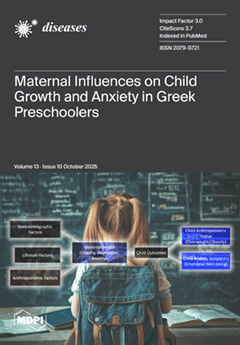Background: Cancer, type 2 diabetes mellitus (T2DM), and psychiatric comorbidities such as depression and anxiety frequently coexist, with shared mechanisms involving systemic inflammation and neuroinflammatory pathways. Understanding these interactions is critical for improving multidisciplinary oncological care.
Methods: We conducted a monocentric
[...] Read more.
Background: Cancer, type 2 diabetes mellitus (T2DM), and psychiatric comorbidities such as depression and anxiety frequently coexist, with shared mechanisms involving systemic inflammation and neuroinflammatory pathways. Understanding these interactions is critical for improving multidisciplinary oncological care.
Methods: We conducted a monocentric cross-sectional study (
n = 174). Beyond descriptive and univariate analyses, we fitted multivariable models: linear regressions (HADS-Anxiety/Depression) with robust HC3 errors and the predictors ECOG, T2DM, age, sex, and residence, and logistic regression for ECOG ≥ 3. We assessed collinearity and model fit, and performed sensitivity checks.
Results: Psychiatric comorbidity was present in 58% of patients, while more than 80% of those with available HADS data (
n = 136) exceeded the clinical threshold for anxiety or depression. No significant differences in ECOG status were observed between patients with and without T2DM (mean ECOG 2.5 in both groups). Higher ECOG remained positively associated with both HADS-Depression (adjusted β = 2.77, 95% CI −1.03–6.57,
p = 0.149) and HADS-Anxiety (β = 1.62, 95% CI −2.76–6.00,
p = 0.468), although not statistically significantly. T2DM showed no independent association with either outcome (Depression β = −2.91,
p = 0.130; Anxiety β = −0.80,
p = 0.595). In logistic regression, T2DM was not significantly associated with ECOG ≥ 3 (aOR = 3.58, 95% CI 0.23–56.66,
p = 0.365).
Conclusions: The psychiatric burden is high among Romanian cancer patients, irrespective of T2DM status, and strongly associated with functional decline. These findings support the relevance of a neuroinflammatory framework linking somatic comorbidities and psychological distress. Routine psychiatric screening, early intervention, and integration of psycho-oncology into multidisciplinary care are recommended. Future prospective studies should incorporate inflammatory biomarkers to better define underlying mechanisms.
Full article






